THE COMPLETE GUIDE TO VISITING CRATER LAKE NATIONAL PARK
If you’ve only ever seen pictures of Crater Lake, you’ve probably thought to yourself, “That can’t be real.” The lake’s deep, matte blue hue looks Photoshopped from afar, an impossibly rich shade that swallows the sunlight and coughs up unspoiled beauty that stretches, uninterrupted, for miles in every direction.
So we don’t blame you for wanting to see for yourself.
Crater Lake, the deepest lake in North America, reaches a depth of 1,943 feet at its base and stretches out for six miles at its widest point. Holding 4.9 trillion gallons of water, Oregon’s only national park offers all manner of activities for visitors enchanted by its iconic beauty. One could spend weeks camping, hiking, stargazing, and swimming at Crater Lake National Park—and still find new views, trails, and vistas to explore.
So whether you’ve got a few hours or several days, here’s the complete guide to the unforgettable sights and unmatched adventure of Crater Lake National Park.
How Crater Lake Became Crater Lake
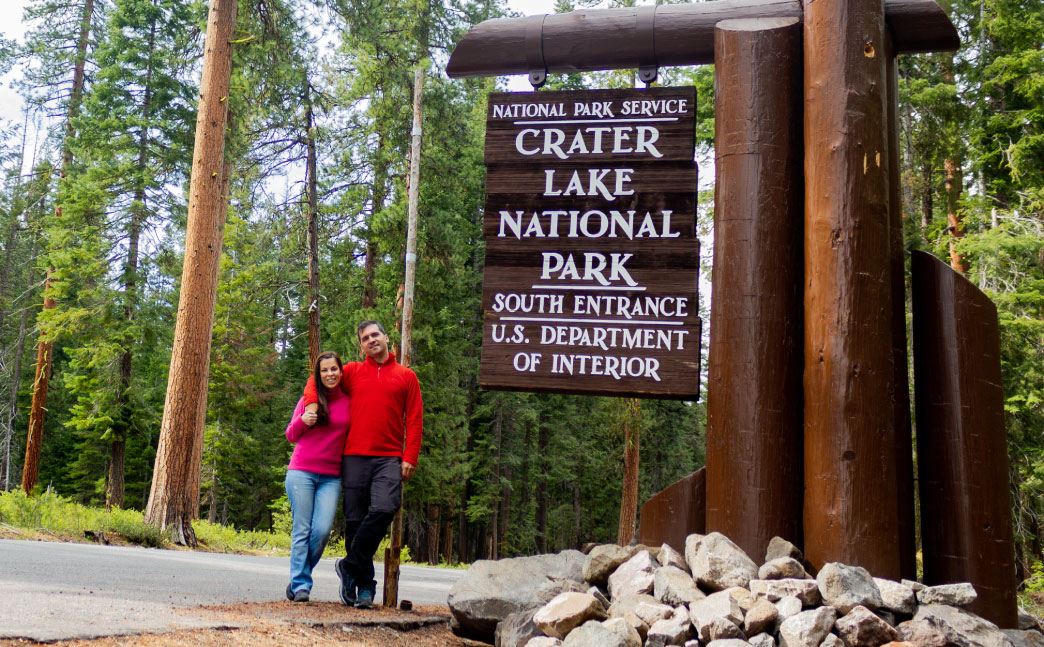
Crater Lake National Park is one of the crown jewels of Oregon and among the state’s most popular tourist destinations. Andre Luis
Where Crater Lake sits today was once Mount Mazama, which rose 12,000 feet over the surrounding Klamath Basin. It erupted about 7,700 years ago, and the volcano’s walls eventually collapsed, leaving behind a bowl-shaped caldera that over the years filled with rainwater and snowmelt. The first European Americans visited the lake in 1853—although local American Indian tribes had long seen Mount Mazama and Crater Lake as a sacred, spiritual place—and President Theodore Roosevelt established Crater Lake as the country’s sixth national park in 1902. Today the park is one of Oregon’s most popular tourist destinations, drawing more than a half-million visitors every year.
When You Should Visit
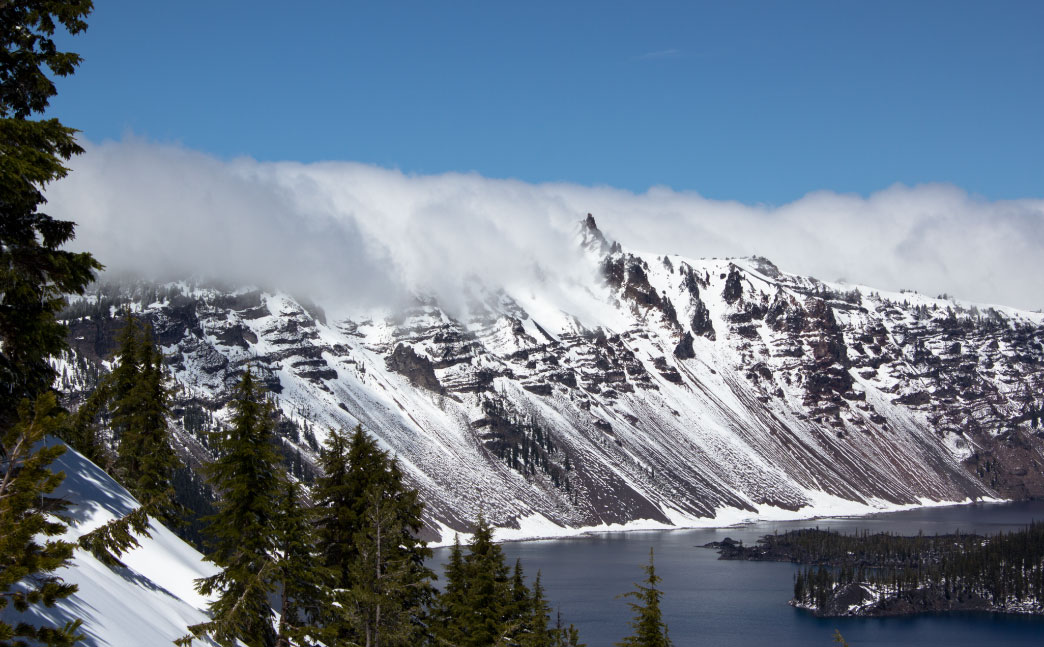
The first snowfall at Crater Lake is usually late fall, and the area generally receives 43 feet of snow a year. Andy Melton
Crater Lake National Park generally experiences just two of the four seasons: winter and summer. The first snow falls at Crater Lake in October or November—and it doesn’t melt until Memorial Day. The park averages 43 feet of snow each year, which is how it became the deepest lake in North America.
You’re free to snowshoe or cross-country ski around the rim (rangers lead snowshoe walks between November and April), and adventurous visitors can pitch a tent on the rim for multi-day treks. (Winter is the only time of year visitors can camp within eyesight of the lake itself.) But be warned, most of the park’s facilities—including restaurants and campgrounds—are closed all winter, so make sure you have plenty of gear, gas, and food before setting out.
The vast majority of Crater Lake’s half-million visitors descend on the park between June and September, when the warmest summer temperatures rarely top 80 degrees. If you’re looking for those idyllic Instagram photos, chances are good the summertime forecast will cooperate. Late spring and early summer is when the park comes out of hibernation: The last of the snow generally melts off trails by late July, lake cruises are offered between late June and early September, and the park’s campgrounds remain open for a few weeks after Labor Day—weather permitting.
Where You Should Stay
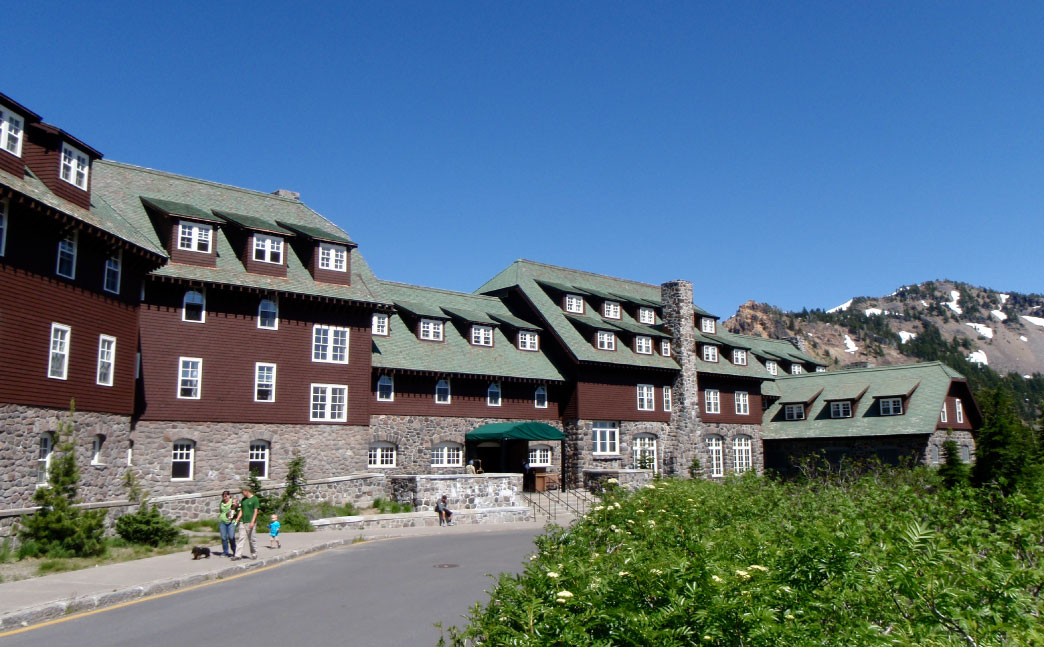
Crater Lake Lodge is one of the national park’s notable places to spend the night. [email protected]
In addition to a number of campgrounds just outside park boundaries, visitors have three options for camping within Crater Lake National Park. Mazama Village Campground is the most developed of the park’s campgrounds, complete with 214 tent and RV sites, fire pits, picnic tables, pay showers, restrooms, water spigots, and bear-proof trash bins. The Lost Creek Campground offers 16 tent-only sites, each including a picnic table, fire ring, food locker, and access to drinking water, sinks, and flush toilets.
If you’d rather get off the grid, Backcountry permits are available for backpackers looking to spend a night our two under the stars. Note that you can’t hike between Rim Drive (which circles the lake) and the rim of the lake itself. Rangers are happy to offer directions to various backcountry sites throughout the park.
If you’d rather not rough it, however, Crater Lake offers a pair of lodging options within the park itself. Crater Lake Lodge includes 71 guest rooms, an expansive restaurant serving regional cuisine, and an inviting lobby featuring free coffee and a scattering of board games. (The lodge fills up weeks, if not months, in advance—so book early, or cross your fingers for cancellations.) The Cabins at Mazama Village sits seven miles from the Crater Lake rim and offers 40 rooms for families not keen on camping. The rustic cabin experience includes one or two queen beds per room, private bathrooms, and free Wi-Fi.
What You Should Do
Naturally, in the summer, you’ll make the 33-mile trek around Rim Drive, stopping at some of the dozens of viewpoints for photos along the way. But you’re missing out by limiting yourself to whatever you can see from the car. Try these experiences for an unforgettable trip to Crater Lake.
Cross-Country Ski and Snowshoe in Winter
Visit Crater Lake at the height of summer, and you’ll routinely rub elbows with tourists from around the world. Visit in winter, though, and you may have the whole park to yourself. Rim Drive is closed to cars each winter, and it becomes a trail for cross-country skiers and snowshoers. Park rangers lead guided snowshoe walks between November and April, but they’re also happy to pass along information about avalanche conditions, recommend routes suited to your skills, and offer tips on what to look for along the way.
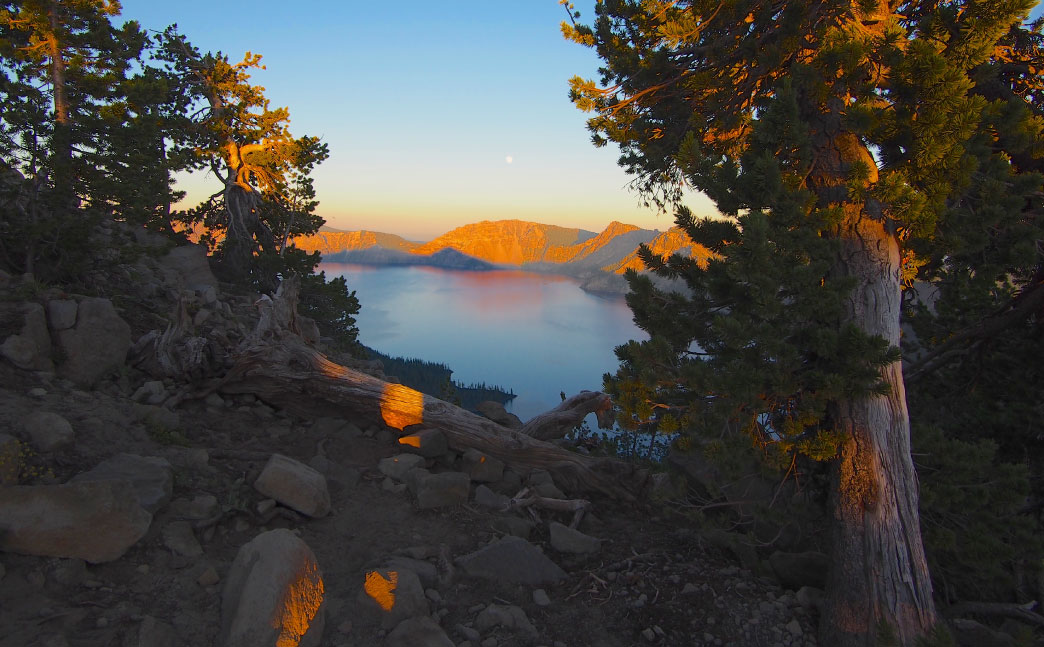
Hike to Watchman Peak for incredible views of the lake. Brian Holsclaw
If you’re visiting Crater Lake in the summer, make time for one (or more) of the park’s iconic hikes. Here are a few favorites:
• Watchman Peak** **promises unobstructed, seemingly bird’s-eye views of Wizard Island.
• Mount Scott takes hikers to the highest point in the park—and offers views of not just the entire lake, but also the surrounding Klamath Basin.
• Cleetwood Cove** **descends to the lake’s shore, where all boat tours depart. If you’re not up for a tour, dive off the rocks and take a dip in the frigid water.
• Wizard Island, the famous island that rises from the lake, is accessible by ferry, and visitors will find 360-degree views from its summit. Daring hikers can peer into the summit crater, known as the Witches Cauldron, which is 90 feet deep.
• Pinnacle Valley offers up-close views of needle-shaped rock formations (known as fossil fumaroles) that preceded the eruption of Mount Mazama.
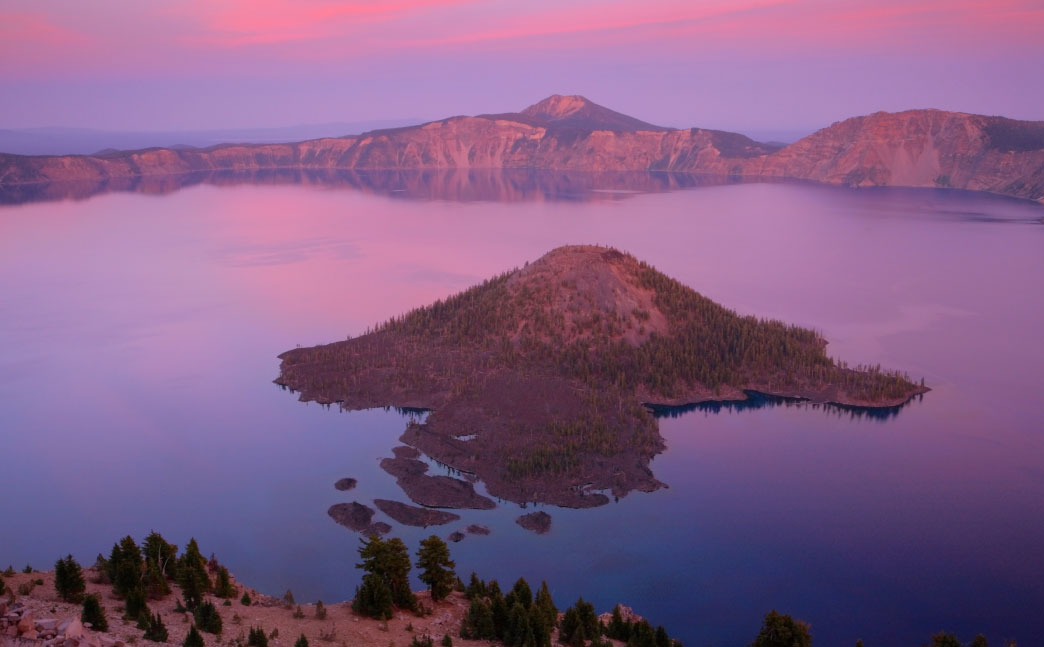
Watch the sun set on the rim. Shahid Durrani
Watch the Sunset and Stargaze on the Rim
Crater Lake’s blue color is memorable—and with good reason—but the lake bathes in fiery shades of red, orange, pink, and purple every night as the sun sets beyond its western shore. Hike up Watchman Peak (rangers lead sunset tours up the trail in the summer) for some of the best sunset views in the park. With low light pollution, limited haze, and no real obstructions, Crater Lake is a stargazer’s dream. Once you’ve put out the campfire, bundle up, head to the rim, and find an unfettered viewpoint—ideally, a few miles removed from the light cast by Crater Lake Lodge—and watch the natural show unfold.
Take a Boat Tour
The only way to get on the water at Crater Lake is via a volcano boat cruise. You’re missing out on incredible history and even better views by not taking a tour. Choose from three options: The Standard Lake Cruise offers a two-hour introduction to Crater Lake, complete with up-close views of the park’s geological features, information about the lake’s importance to American Indians, and other stories about the lake. The Wizard Island Tour combines a Standard Lake Cruise with a three-hour stop at Wizard Island, where you can hike to its summit and enjoy 360-degree views, go fishing in Fumarole Bay, or cannonball off the dock. The Wizard Island Shuttle bypasses the lake cruise but nevertheless gives visitors three hours to explore the island. Whichever tour you choose, you must take the 1.1-mile trail to Cleetwood Cove, which gains 700 feet on the return hike.
No matter when you visit, Crater Lake offers incredible views and a stunning, once-in-a-lifetime outdoor experience. You’ll quickly learn for yourself that the photographs are indeed telling the truth.
Written by Matt Wastradowski for RootsRated in partnership with Discover Klamath Visitor and Convention Bureau.


